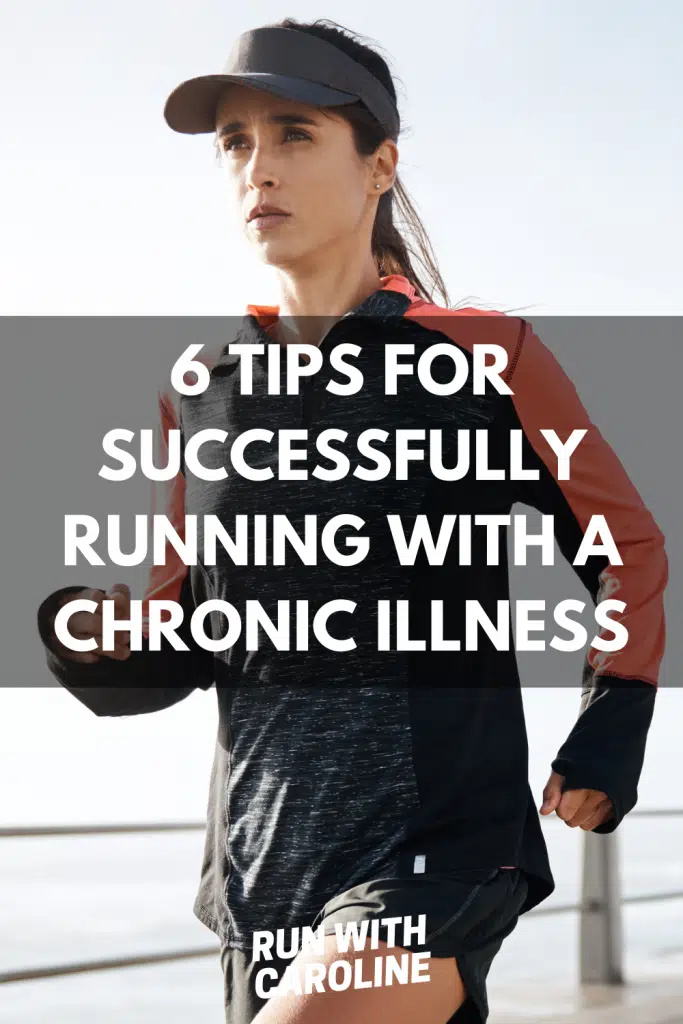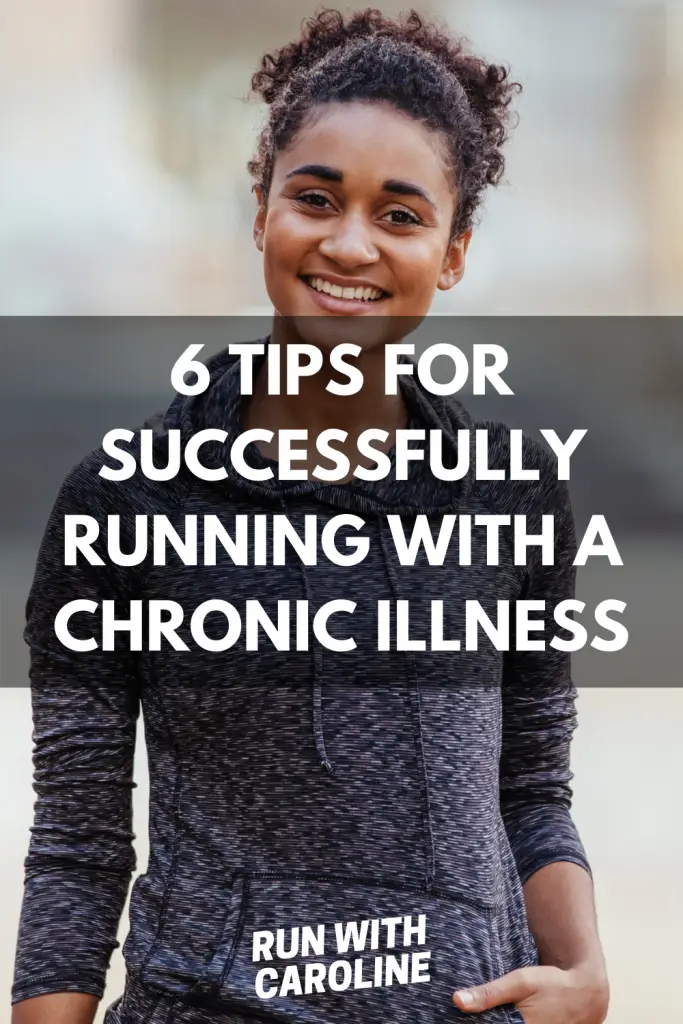Chronic illnesses like diabetes, Crohn’s disease and asthma can have a huge impact on your life.
However, your diagnosis doesn’t mean you have to turn in your running shoes for good.
There are many ways to keep successfully running with a chronic illness.
In 2018, I was diagnosed with endometriosis – a chronic illness that affects 1 in 10 women around the globe.
Endometriosis is a condition where tissue similar to the lining of the womb starts to grow in other places, such as the ovaries and fallopian tubes.
It may come as a surprise to you to learn that I even have a chronic illness.
But many chronic illnesses like endometriosis are illnesses that are all but invisible to the naked eye.
Despite looking healthy from the outside, these hidden illnesses can have a significant impact on those living with them.
Before I was diagnosed with endometriosis, I experienced symptoms that would quite literally stop me in my tracks.
During the time of the month, if I decided to go for a run, period pain would often cut my long run short.
Instead of leaping like a gazelle, I was doubled over on the pavement in pain.
As my symptoms got worse over time, I knew I had to see someone who could tell me why this was happening.
Surely, severe period pain that would last for weeks was not normal!
Fast forward to today and with a diagnosis I feel more empowered to manage and control my symptoms.
Although there is no cure for endometriosis, I have learnt a lot about the condition over the years and I have made changes in my life to try and ease my symptoms.
I’m pleased to say that after the diagnosis, running still plays a pivotal role in life.
Running and exercise are my go to activities to relieve any stress and anxiety that I might be feeling.
Being outdoors in the fresh air, moving my body, there really is nothing better.
If you’re reading this as someone with a chronic illness, I’m here to tell you that your diagnosis doesn’t define you and you don’t have to hang up your running shoes.
As someone living with a long-term illness, I’d like to share a few tips on successfully running with a chronic illness.
Whether it’s rethinking your training or figuring out what works for you in your ‘new normal’, hopefully these tips will provide you with some reassurance that all is not lost and you can continue doing the thing you love.

6 tips for successfully running with a chronic illness
#1 Stay active
This is such an important point when it comes to living with a chronic illness.
When I was diagnosed with endometriosis, all I wanted to do was crawl into my bed at home and hide away.
Staying active is just as important as finding the right treatment plan and medication.
Various studies over the years have proven the link between exercise and chronic disease.
One study comments that being physically inactive is associated with increased chronic disease risk.
Adding that increased physical activity and exercise are associated with reduced chronic disease risk.
Running provides many physical and mental benefits which go a long way to improve your wellbeing and strengthen your sense of self.
Although you might not be able to attack your training plan like you once did, by making small, incremental changes, you can still enjoy running and stay active as much as possible.
Respect your body and find additional ways to exercise.
Activities like walking, yoga, barre and Pilates are great ways to move your body in a more gentle way, and these are also great cross training activities to complement your running.
Related: What is cross training? Essential cross training tips for runners
#2 Adjust your training plan
You may find you have to adjust your training to better manage your illness, especially if you find it flares up during your runs.
Successfully running with a chronic illness is all about compromise.
There were times when I was running and I would experience a flare up.
These became more and more common, and after a while I would stop planning my long runs, worried that I would have to stop or be stuck in the middle of nowhere in the midst of a painful flare up.
Since those early days of my diagnosis, I have learnt to schedule my runs during times when I think I’ll be less likely to have a flare up.
I also plan my routes so that I am close to public transport in case I need to get the train back, or call my husband to pick me up.
You may find your training needs to slow down and become less intensive whilst you get used to your illness. Your goals may also need to shift in line with this.
Whatever you do, don’t put too much pressure on yourself to perform. Whilst it’s natural to want to achieve that next PB or run your fastest Parkrun, you may need to give your body time.
Related: Do you burn more calories on your period? Your common questions answered

#3 Be prepared
For many, dealing with a chronic illness means eating a restricted diet, taking certain medications and making sure you have access to a toilet nearby.
My diagnosis means I have to restrict certain foods from my diet – basically anything with dairy, gluten or soy in it.
This can be challenging when preparing food and making sure I eat enough before my long runs, but it’s all about preparation!
Here are some tips when preparing for your runs:
- If you take medication, make sure you have extras in your race belt or race bag.
- If you have a restricted diet, make sure you bring your own food to races.
- If you have irritable bowel syndrome (IBS), focus on eating anti-inflammatory foods the night before your run to minimise any potential flare ups.
Related: Should you work out on your period? 6 best exercises
#4 Focus on health and wellness
Nutrition, sleep and recovery are important for any runner, but they become more important for a runner dealing with a chronic illness.
Often with my endometriosis, my sleep and food habits trigger my symptoms.
For example, if I don’t get enough sleep or I eat the wrong types of foods, this will case a flare up.
Eating the right foods is critical when dealing with a chronic illness, especially if it is triggered by certain foods or foods that cause inflammation, such as dairy or gluten.
I follow the 80/20 rule and try and follow a restricted diet 80% of the time. We all need a break now and again to indulge!
Sleep, and more importantly getting a good night’s sleep, is also essential so you feel at your best.
I know this can be hard if you are managing painful symptoms throughout the night, but try and get at least 8 hours of sleep per night.
Related: Is it safe to exercise during IVF? Here’s what the science tells us

#5 Don’t be too hard on yourself
The biggest lesson for me since being diagnosed with a chronic illness, and even more so recently during lockdown, is not to put too much pressure on myself to perform.
I remember the days when I would set out for a run without a care in the world. I wouldn’t be worried about pain or worried about how I would get home if I suddenly had a flare up.
At first I was so hard on myself for not being able to run long runs every weekend.
A 5k feels like a huge achievement some days!
But I knew that if I kept berating myself, it would soon become toxic, so I started to accept that I could no longer run all the miles every weekend and would have to take a step back.
Any distance – no matter if it’s 1k, 3k, 5k, 10k or 20k – is still a run!
Nowadays, I run for how it makes me feel, not how far I can go.
Although it still feels good to start a new training plan, or complete a Parkrun (when they come back), I’m happy with just being able to run.
By reframing how I see running – not always as a competition with myself and instead as a way to unwind and de-stress – I started to be kinder to myself.
Related: What is an endometriosis flare up? Exercising with endometriosis

#6 Find a support network
One of the best things about the internet is that it’s easier than ever to find groups of people who just ‘get’ what you’re going through.
When you’re dealing with a chronic illness, it can be hard to find people in your everyday life, such as family, friends and work colleagues, who understand your condition and how it makes you feel.
This is why I turned to online support networks and groups to meet other women.
These are people who know exactly how it feels to have a chronic illness like endometriosis, and how it can impact every day things like fitness and exercise.
Many times I have turned to this group of ladies to share my feelings and frustrations, and all the thoughts that come with having a chronic illness.
Facebook is a great platform to find groups.
Many charities like Endometriosis UK also have their own support groups which they advertise on their website, so be sure to look there too.
Related: 10 running clubs changing the world one step at a time
- 5 things I wish I’d known before returning to running - March 3, 2024
- Running 20 minutes a day: Benefits + how to start - January 27, 2024
- How to run your first 2 hour half marathon - January 16, 2024

Teresa
Tuesday 3rd of October 2023
Thank you, Caroline. I have endometriosis too! I ran cross country in high school, but as my disease progressed, it changed my relationship to running. I'm trying to get back into it, but I can't copy my old routine exactly. This is helpful.
Caroline Geoghegan
Friday 6th of October 2023
Hi Teresa. Thanks for your reply. I'm so sorry to hear you are suffering with endometriosis too - it's an awful disease isn't it! It has definitely had an impact on my running too - I now find it's about finding ways to work around it. I hope you're ok and managing your symptoms - feel free to email me directly if you ever want to chat about anything endo related :). Thanks, Caroline